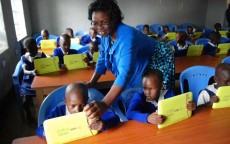- Students in Primary and Secondary schools may also face a bleak future following a strike notice for August 26, 2024, issued by KNUT and KUPPET, stating that they won’t resume teaching as the school plans to reopen the week starting August 25, 2024.
Education lifts people out of poverty, but the education system in Kenya faces hurdles that could render the future generation uneducated, continuing the cycle of poverty. Even though invisible to many for now, the fruits of the future are dependent on the current actions.
For the past few months, controversies surrounding the new Higher Education Funding Model have brought to light that education in Kenya runs smoothly for those with money. The New Higher Education Funding model is meant to support the finances of those unable to. In this context, they term as the “poor”.
The model categorizes families into five bands, using “how poor” as the criteria. The first band is for families whose highest monthly income is up to Sh5,995. In this category, a government scholarship will cover 70 per cent of the fees while the loan will cover 25 per cent, making the total support 95 per cent.
The second band involves those families who earn up to Sh23,670. In this category, the government scholarship will cover 60 per cent while the loan will cover 30 per cent.
The third and fourth bands have Sh70,000 and Sh120,000 monthly incomes, respectively. The government scholarship will cover 50% and 40%, while the loan will cover 30% in both bands.
Read More
In the fifth band, with monthly income above Sh120,000, families will pay 30 per cent of fees, receive 30 per cent as a loan, and the government will cover 40 per cent.
The new Higher Education Funding model, introduced by President William Ruto in May 2023, replaces the Differentiated Unit Cost (DUC) previously used to finance universities.
Even though this funding formula appears reasonable, reports indicating that some students are allocated the higher income bands despite deserving to be ranked under the lower income bands are discriminatory. This prevents them from accessing the financial support they need.
Several leaders have opposed the model, terming it as lacking a proper formula for identifying the needy and less needy students.
Another issue is the grading of schools, especially for children in slum areas attending private schools funded by donors.
According to the Measuring Testing Instrument (MTI), students from these schools receive lower funding scores, as private schools are perceived to cater to wealthier families. What happens to these students when they are set to join universities and colleges? This misconception shuns a majority of sponsored students from accessing higher education.
As Chief Justice Martha Koome rightly asserted, "education can be better managed if all bursaries are collapsed into one fund to finance education for all,” it is high time that education is given to all without any categorization.
Students in Primary and Secondary schools may also face a bleak future following a strike notice for August 26, 2024, issued by the Kenya National Union of Teachers (KNUT) and Kenya Union of Post Primary Education Teachers (KUPPET), stating that they won’t resume teaching as the school plans to reopen the week starting August 25, 2024.
The two union bosses assert that the Teachers Service Commission have been evasive concerning several demands, including the promotion of 130000 teachers who were shortlisted and interviewed but have remained stagnant in their job groups, the confirmation of 46,000 intern teachers under permanent and pensionable terms as well as the recruitment of 20,000 new teachers for Junior Secondary School (JSS).
In all these two cases, the student is the one to bear the burden. If the teachers’ strike goes as planned, schools won’t reopen on time, affecting thousands of learners,, most of whom are waiting their national examinations by the end of this year.












